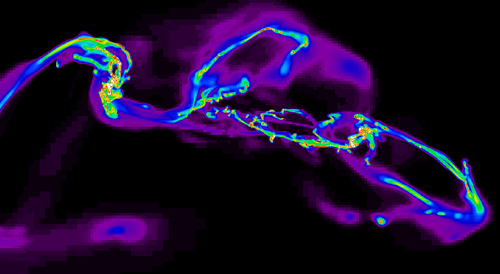ASTROPHYSICS
Star Formation in Extreme Conditions
Principal Investigator:
Frederic Bournaud
Affiliation:
CEA Saclay (France)
Local Project ID:
pr86di
HPC Platform used:
SuperMUC of LRZ
Date published:
Numerical simulations are a crucial tool to understand the physics of gas turbulence and star formation: there is no analytic theory. More than six decades of spatial scales need to be described, which is best done with "adaptive resolution" codes on supercomputers.
How galaxies form their stars, and why only 20 percent of the gas reservoirs available in the universe have been converted into stars over its 13 billion-year-long life, are major questions of modern astrophysics. The triggering of star formation and its regulation are thought to be largely governed by „turbulence“, an ensemble of chaotic motions that take place in any gaseous system. Over the scales of galaxies, turbulence is generally quite strong several times the speed of sound, or tens of kilometres per second. These supersonic motions can compress pieces of gas until they become unstable under the effect of gravity and collapse into star sand. They will, when they happen to be divergent, prevent the gas from collapsing by creating large voids with low densities, quasi-insensitive to the effects of gravity. Numerical simulations are a crucial tool to understand the physics of gas turbulence and star formation: there is no analytic theory. More than six decades of spatial scales need to be described, which is best done with „adaptive resolution“ codes on supercomputers. Simulations on GCS supercomputers aim at reproducing the physics of groups of galaxies in mutual interaction, in order to understand why they can undergo „starbursts“ where their rate of star formation suddenly increases by factors as large as 100. Storing the physical information related to interstellar gas physics (more than 4 TB of data at any time), and calculating the evolution over the duration of a starburst became possible only with the arrival of petascale HPC systems.

Figure 1: The image shows the gas density in a pair of interacting galaxies. The interaction has triggered supersonic turbulence motion, helping the gas to fragment into very dense pieces – future clusters of new stars.
Copyright: DSM/IRFU/SAp, Service d‘Astrophysique, CEA Saclay, FranceScientific Contact:
Frederic Bournaud
DSM/IRFU/SAp, Service d‘Astrophysique
CEA Saclay, France
e-mail: frederic.bournaud@cea.fr